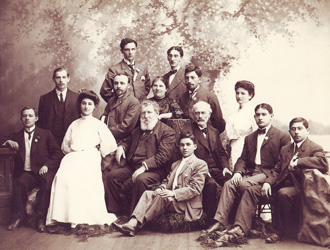The genesis of Conservative Judaism
Conservative Judaism, which in the years following World War II was the largest branch of Jewish observance in America, is the subject of a book by Tulane Jewish studies scholar Michael Cohen. The book explores the origins of the Conservative Judaism movement, unraveling its founding myth to understand the challenges it faces today.

Rabbi Solomon Schechter, together with a group of his disciples and their wives who developed Conservative Judaism, vacation in the Catskills circa 1910. The origins of the movement are the subject of a book by Michael Cohen. (Photo from the personal collection of Vivian Rous)
The Birth of Conservative Judaism: Solomon Schechter's Disciples and the Creation of an American Religious Movement was published this year by Columbia University Press. As Conservative Judaism today seeks to reclaim its place atop the American Jewish spectrum, Cohen suggests that it was never intended to be a separate movement. He argues that the disciples of Rabbi Solomon Schechter created Conservative Judaism during the the first half of the 20th century by emphasizing inclusivity and diversity.
Conservative Judaism was created as a movement to unify American Jews, but was rejected by those on the right and on the left, ironically transforming a movement advocating unity into one with its own boundaries, says Cohen, an assistant professor in the Jewish Studies Department and a 2011-12 Monroe Fellow at the New Orleans Gulf South Center at Tulane University.
“Understanding the way the movement came to be is essential to the debate over what the movement is and what the movement will be,” Cohen says. “This movement wasn't created to be distinct; it was created to bring in diversity of opinion.”
As the movement today struggles to regain its share of American Jewish life, Cohen notes, “It's a dilemma: when you embrace unity, ultimately you have to exclude some.”
